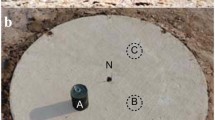Abstract
The idea that ants communicate when meeting on a trail is beguiling, but evidence for this is scarce. Physical communication in ants has been demonstrated to play a role as a modulator of behaviours such as alarm and recruitment. Honeybees can communicate the location of a resource using an advanced motor display—the waggle dance. However, no equivalent of the waggle dance has been described for any ant species, and it is widely believed that ants cannot communicate the location of resources using motor displays. One group of researchers report several demonstrations of such communication in Formica ants; however, these results have been largely ignored. More recently some evidence arose that Lasius niger foragers returning from a food source can communicate to outgoing foragers the direction that should be taken at the next bifurcation by means of physical contact on the trail. Here, we make a concerted effort to replicate these results. Although initial results seemed to indicate physical communication, once stringent controls to eliminate pheromone cues were put in place, no evidence for physical communication of food location could be found. This null result was replicated independently by a different research group on a closely related species, L. neglectus. We conclude that neither L. niger nor L. neglectus foragers communicate resource location using physical contact. Our results increase the burden of proof required for other claims of physical communication of direction in ants, but do not completely rule out this possibility.




Similar content being viewed by others
Change history
06 July 2018
In the original publication of the article, the ORCID ID of author Stefan Popp was incorrect. The correct ORCID ID is given below:
References
Akino T, Yamamura K, Wakamura S, Yamaoka R (2004) Direct behavioral evidence for hydrocarbons as nestmate recognition cues in Formica japonica (Hymenoptera: Formicidae). Appl Entomol Zool 39:381–387
Aron S, Beckers R, Deneubourg J, Pasteels JM (1993) Memory and chemical communication the orientation of two mass-recruiting ant species. Insectes Soc 40:369–380. doi:10.1007/BF01253900
Balbuena MS, Molinas J, Farina WM (2012) Honeybee recruitment to scented food sources: correlations between in-hive social interactions and foraging decisions. Behav Ecol Sociobiol 66:445–452. doi:10.1007/s00265-011-1290-3
Bates D, Maechler M, Bolker B, Walker S (2014) lme4: linear mixed-effects models using Eigen and S4. R package version 1(7):1–23
Beckers R, Deneubourg JL, Goss S, Pasteels JM (1990) Collective decision making through food recruitment. Insectes Soc 37:258–267
Beckers R, Deneubourg JL, Goss S (1993) Modulation of trail laying in the ant Lasius niger (Hymenoptera: Formicidae) and its role in the collective selection of a food source. J Insect Behav 6:751–759. doi:10.1007/BF01201674
Benjamini Y, Hochberg Y (1995) Controlling the false discovery rate: a practical and powerful approach to multiple resting. J R Stat Soc Ser B Methodol 57:289–300
Bhatkar A, Whitcomb WH (1970) Artificial diet for rearing various species of ants. Fla Entomol 53:229–232
Bonavita-Cougourdan A, Morel L (1984) Les activités antennaires au cours des contacts trophallactiques chez la fourmi Camponotus vagus Scop. Ont-elles valeur de signal? Insectes Soc 31:113–131. doi:10.1007/BF02232709
Collett M, Chittka L, Collett TS (2013) Spatial memory in insect navigation. Curr Biol 23:R789–R800. doi:10.1016/j.cub.2013.07.020
Core Team R (2012) R: a language and environment for statistical computing. R Foundation for Statistical Computing, Vienna
Czaczkes TJ, Heinze J (2015) Ants respond to a changing environment and making errors by adjusting pheromone deposition. Proc R Soc B Biol Sci. doi:10.1098/rspb.2015.0679
Czaczkes TJ, Schlosser L, Heinze J, Witte V (2014) Ants use directionless odour cues to recall odour-associated locations. Behav Ecol Sociobiol 68:981–988. doi:10.1007/s00265-014-1710-2
Czaczkes TJ, Czaczkes B, Iglhaut C, Heinze J (2015a) Composite collective decision-making. Proc Biol Sci 282(1809):20142723
Czaczkes TJ, Grüter C, Ratnieks FLW (2015b) Trail pheromones: an integrative view of their role in colony organisation. Annu Rev Entomol 60:581–599. doi:10.1146/annurev-ento-010814-020627
Czaczkes TJ, Salmane AK, Heinze J, Klampfleuthner FAM (2016) Private information alone can cause trapping of ant colonies in local feeding optima. J Exp Biol 219:744–751. doi:10.1242/jeb.131847
Czaczkes TJ, Castorena M, Schürch R, Heinze J (2017) Pheromone trail following in the ant Lasius niger: high accuracy and variability but no effect of task state. Physiol Entomol 44(1):91–97. doi:10.1111/phen.12174
Dacke M, Srinivasan MV (2008) Evidence for counting in insects. Anim Cogn 11:683–689. doi:10.1007/s10071-008-0159-y
Devigne C, Detrain C (2006) How does food distance influence foraging in the ant Lasius niger: the importance of home-range marking. Insectes Soc 53:46–55. doi:10.1007/s00040-005-0834-9
Evison SEF (2008) Foraging organisation in ants. PhD Thesis, University of Sheffield. Available online at http://ethos.bl.uk/OrderDetails.do?uin=uk.bl.ethos.500109
Evison SEF, Petchey OL, Beckerman AP, Ratnieks FLW (2008) Combined use of pheromone trails and visual landmarks by the common garden ant Lasius niger. Behav Ecol Sociobiol 63:261–267. doi:10.1007/s00265-008-0657-6
Farina WM, Grüter C, Díaz PC (2005) Social learning of floral odours inside the honeybee hive. Proc R Soc B Biol Sci 272:1923–1928. doi:10.1098/rspb.2005.3172
Forstmeier W, Schielzeth H (2011) Cryptic multiple hypotheses testing in linear models: overestimated effect sizes and the winner’s curse. Behav Ecol Sociobiol 65:47–55. doi:10.1007/s00265-010-1038-5
Goss S, Aron S, Deneubourg JL, Pasteels JM (1989) Self-organized shortcuts in the Argentine ant. Naturwissenschaften 76:579–581. doi:10.1007/BF00462870
Grüter C, Balbuena MS, Farina WM (2008) Informational conflicts created by the waggle dance. Proc R Soc B Biol Sci 275:1321–1327. doi:10.1098/rspb.2008.0186
Grüter C, Czaczkes TJ, Ratnieks FLW (2011) Decision making in ant foragers (Lasius niger) facing conflicting private and social information. Behav Ecol Sociobiol 64:141–148. doi:10.1007/s00265-010-1020-2
Hölldobler B (1971) Recruitment behavior in Camponotus socius (Hym. Formicidae). J Comp Physiol A Neuroethol Sens Neural Behav Physiol 75:123–142. doi:10.1007/BF00335259
Hölldobler B (1976) Recruitment behavior, home range orientation and territoriality in harvester ants, Pogonomyrmex. Behav Ecol Sociobiol 1:3–44. doi:10.1007/BF00299951
Hölldobler B, Wilson EO (1978) The multiple recruitment systems of the african weaver ant Oecophylla longinoda (Latreille) (Hymenoptera: Formicidae). Behav Ecol Sociobiol 3:19–60. doi:10.1007/BF00300045
Hölldobler B, Wilson EO (1990) The ants. Springer, Berlin
Huber P (1810) Recherchez sur les Meœrs des Fourmis lndigenes. JJ Paschoud, Paris
Kennedy P, Baron G, Qiu B et al (2017) Deconstructing superorganisms and societies to address big questions in biology. Trends Ecol Evol. doi:10.1016/j.tree.2017.08.004
Le Breton J, Fourcassie V (2004) Information transfer during recruitment in the ant Lasius niger L. (Hymenoptera: Formicidae). Behav Ecol Sociobiol 55(3):242–250
Lenoir A (1982) An informational analysis of antennal communication during trophallaxis in the ants Myrmica Rubra L. Behav Processes 7:27–35
Lenoir A, Depickère S, Devers S et al (2009) Hydrocarbons in the ant Lasius niger: from the cuticle to the nest and home range marking. J Chem Ecol 35:913–921. doi:10.1007/s10886-009-9669-6
McCabe S, Farina W, Josens R (2006) Antennation of nectar-receivers encodes colony needs and food-source profitability in the ant Camponotus mus. Insectes Soc 53:356–361. doi:10.1007/s00040-006-0881-x
Novgorodova TA (2006) Experimental investigation of information transmission in Formica pratensis (Hymenoptera, Formicidae) using “binary tree” maze. Entomol Rev 86:287–293. doi:10.1134/S0013873806030043
Novgorodova TA (2015) Organization of honeydew collection by foragers of different species of ants (Hymenoptera: Formicidae): effect of colony size and species specificity. Eur J Entomol 112:688–697. doi:10.14411/eje.2015.077
Ozaki M, Wada-Katsumata A, Fujikawa K et al (2005) Ant nestmate and non-nestmate discrimination by a chemosensory sensillum. Science 309:311–314. doi:10.1126/science.1105244
Reznikova Z (2007) Dialog with black box: using information theory to study animal language behaviour. Acta Ethologica 10:1–12
Reznikova Z (2008) Experimental paradigms for studying cognition and communication in ants (Hymenoptera: Formicidae). Myrmecol News 11:201–214
Reznikova Z (2017) Studying animal language without translation: an insight from ants. Springer, Cham
Reznikova Z, Ryabko B (1994) Experimental study of the ants’ communication system with the application of the information theory approach. Memorab Zool 48:219–236
Reznikova Z, Ryabko B (2001) A study of ants’ numerical competence. Comput Inf Sci 6(15):1–12
Roces F (1990) Olfactory conditioning during the recruitment process in a leaf-cutting ant. Oecologia 83:261–262. doi:10.1007/BF00317762
Roces F (1994) Odour learning and decision-making during food collection in the leaf-cutting ant Acromyrmex lundi. Insectes Soc 41:235–239. doi:10.1007/BF01242294
Salo O, Rosengren R (2001) Memory of location and site recognition in the ant Formica uralensis (Hymenoptera: Formicidae). Ethology 107:737–752
Seifert B (2007) Die Ameisen Mittel-und Nordeuropas. Lutra Verlag, Augsburg
Smith JD, Beran MJ, Couchman JJ, Coutinho MVC (2008) The comparative study of metacognition: sharper paradigms, safer inferences. Psychon Bull Rev 15:679–691. doi:10.3758/PBR.15.4.679
Sudd JH (1967) An introduction to the behaviour of ants. Edward Arnold, London
von Frisch K (1923) Über die” Sprache” der Bienen. Zool Jb Physiol 40:1–186
von Frisch K (1967) The dance language and orientation of bees. Harvard University Press, Cambridge
von Thienen W, Metzler D, Choe D-H, Witte V (2014) Pheromone communication in ants: a detailed analysis of concentration-dependent decisions in three species. Behav Ecol Sociobiol 68:1611–1627. doi:10.1007/s00265-014-1770-3
Wasmann E (1905) Comparative studies in the psychology of ants and of higher animals, 2nd edn. B. Herder, London
Wehner R, Menzel R (1990) Do insects have cognitive maps? Annu Rev Neurosci 13:403–414
Acknowledgements
Many thanks to two anonymous reviewers for comments on an earlier version of this manuscript. TJC was supported by a DFG Emmy Noether group leader grant (Grant number CZ 237/1-1). PBB was supported by a NERC Industrial CASE studentship with Hymettus awarded to EJHR (NE/L008904/1).
Author information
Authors and Affiliations
Corresponding authors
Electronic supplementary material
Below is the link to the electronic supplementary material.
Rights and permissions
About this article
Cite this article
Popp, S., Buckham-Bonnett, P., Evison, S.E.F. et al. No evidence for tactile communication of direction in foraging Lasius ants. Insect. Soc. 65, 37–46 (2018). https://doi.org/10.1007/s00040-017-0583-6
Received:
Revised:
Accepted:
Published:
Issue Date:
DOI: https://doi.org/10.1007/s00040-017-0583-6




